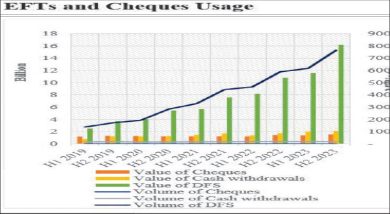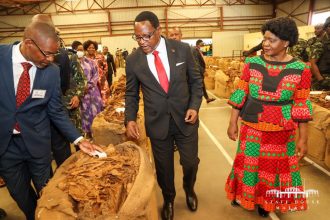Dyke facilitates rural economic development
Zainab Maida and her family could still have been holding double temporary settlements if the community did not manage a dyke constructed in her area in 2012.
For the past 10 years she has been in marriage, the 40-year-old mother of five continued to shift back and forth during and after the rainy season as a result of Lipimbi River breaking its banks, which usually displaced many households in the area.

“Every rainy season, we were forced to move to upper land at Mbalame Village where we will live with relations for fear of losing lives and property if we remained where all the water from Lipimbi River gushes through,” Maida recollects.
She and her family would stay away for three to four months before continuing with their lives, adding that on return, the first assignment would be to reconstruct their shuttered shacks which they called home.
Maida said there was no difference between the shelter they used to stay at Mbalame and the one back home at the flood-prone area because both were nothing but temporary dwelling units.
“We had a mud and mortar house which we could renovate after the rainy season, and at Mbalame, we used to construct a shelter made of reed, grass and plastic sheets which we had to reconstruct at the beginning of each rainy season.
“We did all this to avoid losing our land at Makanjira while at the same time saving our lives and the little property we possessed,” she explained, with a smile plastered on her face.
Maida’s predicament was not restricted to her household alone as almost 80 percent of the population in the area of group village head Makanjira was reduced to such a situation as attested by vice-chairperson for Makanjira Area Civil Protection Committee Sheik Alhaj Mubarak Saidi.
He observed that not many people could build long-term relationships with their neighbours nor could they raise livestockto sustain their livelihoods.
“Moving back and forth was very involving. One could not even think of constructing a house because they were sure that come rains, they will have to abandon their nice houses for fear of being washed away,” Saidi explained.
He said people were not willing to leave permanently because that is their ancestral land and that prospects of acquiring land elsewhere were almost non-existent.
“The places where we used to run to were just for refuge purposes. This is our home and we know nowhere else as home, so it was a bit harder for us to give up on this land,” Saidi added.
He attributes the construction of the dyke to permanent resettlement which has seen mushrooming of decent houses built with baked bricks and roofed with corrugated iron sheets throughout the area, which used to be a death trap during the rainy season.
A tour through Makanjira Village in Traditional Authority (T/A) Makanjira, which directly faces Lipimbi River, showed a good percentage of newly- constructed houses fit for permanent structures.
One of the aspects of human life that has greatly improved in the area since the dyke was constructed is socio-economic development at household level.
Saidi said before the dyke was constructed, uncertainty rocked community members of Makanjira resulting in many of them failing to engage in meaningful household development activities such as farming and livestock production.
He said: “You might agree with me that the pillars of household economic development lie in things such as livestock.
“In the absence of that then, there cannot be sustainable development because an average household’s economy begins with crop and livestock production followed by businesses.”
The dyke has indeed contributed to national development considering that out of 50 households, at least 25 to 30 are raising livestock.
“I have personally bought 10 cows from my farming over the past eight years, something that would not have otherwise been possible before the dyke was constructed,” said Saidi.
Additionally, over 4 000 households which were usually affected by the overflowing of Lipimbi River now have reclaimed their livelihoods and have settled in one place.
Nevertheless, while the dyke at Lipimbi River takes all the credit for facilitating reconstruction of people’s lives, one common issue that affects dykes in many districts was community participation and willingness to manage the structure so that it continues to protect such communities.
William Sanudi, Lipimbi Dyke Management Committee said they realised that the relationship between beneficiary communities and the dyke needed to be symbiotic, whereby people safeguard the facility so that it continues to protect lives.
“We agreed to plant trees along the dyke to re-enforce it and as you can see that there are bluegum and acacia trees. When these trees grow, we plant new ones and sale the old ones so that the money can assist in sustaining the dyke management committee,” he said.
The group recently put beehives in the nearby woodlot created along the dyke as one way of enhancing economic growth for the committee members.
Humphrey Magalasi, assistant district disaster risk management officer for Salima District Council commended Makanjira Area Civil Protection Committee for maintaining the dyke and exploring its uses by utilising its economic potential.
During a study tour by Phalombe District Civil Protection Committee to learn how the dyke was constructed and managed, he observed that community participation was key to its maintenance.
“Sometimes district councils decide to construct dykes in some areas without the involvement of community members in planning and implementation.
“This leads to lack of community ownership which affects sustainability,” said Magalasi.
Phalombe is one of the flood-prone districts and every year, an average of 22 000 households are rendered homeless due to heavy rains.
Florence Harawa, Phalombe District Council assistant district disaster risk management officer said over the past years, a number of dykes have been constructed in the district, noting that not many of such structures have produced desirable results compared to the Makanjira dyke in Salima, which has facilitated resettlement.
She said lessons from the study tour would inform an improvement in the way Phalombe District engages community members in the construction and management of dykes.
“The trip to Salima has revealed a number of things in the way the council ought to engage concerned communities to effectively contribute in the construction and management of dykes in a particular area,” said Harawa.





